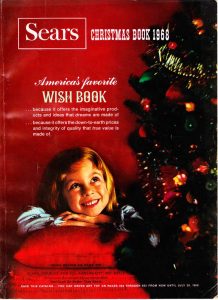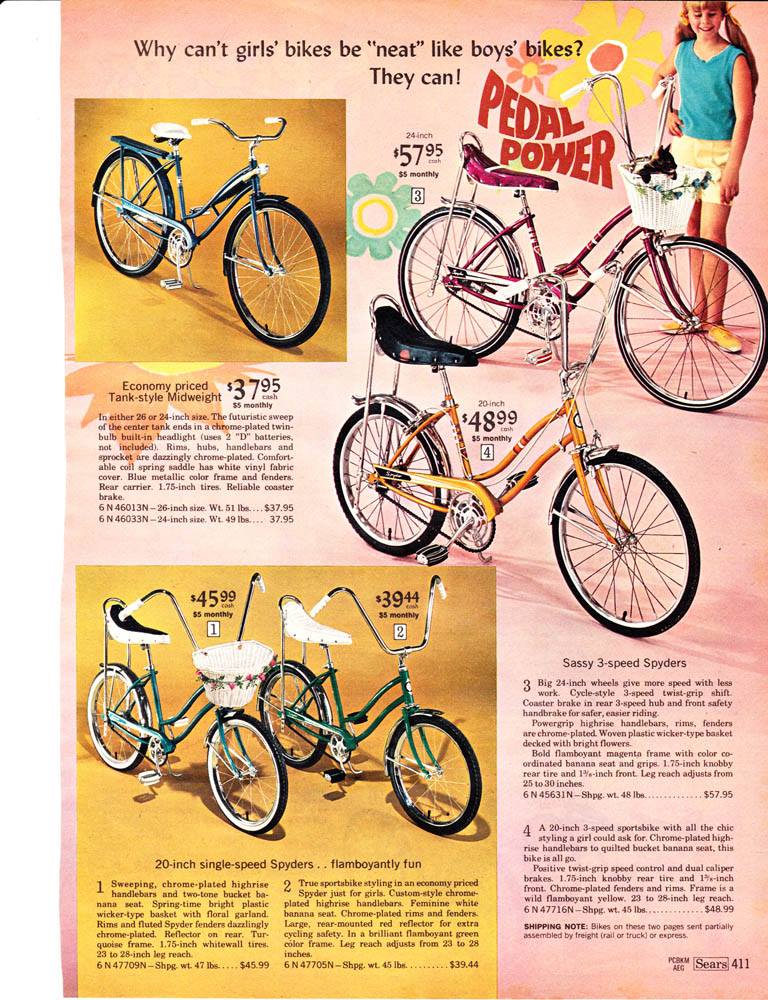It smelled of new ink on crisp, clean paper and told more stories than Scheherazade did in 1,001 Arabian Nights. Thousands of children and about as many adults soaked it up like a sponge. It told stories of glamour and intrigue, stories of fun and adventure, and stories of dreams and imagination. Its very title invited us to run our hands over its slick cover and dared us to peek inside and lose ourselves in its pages.
What was this extraordinary book? Why! It was The WISH BOOK, of course! Sears Wish Book filled our minds with the wonder of Christmas and brought the excitement of Santa Claus to our lives each year.
 First published in 1933*, The Wish Book sported the gifting wares of Sears Roebuck and Company and was one of several catalogs published by the company every year. For us, the pages of all those Sears catalogs brought the world outside our isolated mountains a little closer and gave us a multitude of specialty stores at our fingertips. True, we couldn’t see, hold, or try on the actual items, but that didn’t matter. The excitement and expectation of waiting for them to arrive made up for all of that.
First published in 1933*, The Wish Book sported the gifting wares of Sears Roebuck and Company and was one of several catalogs published by the company every year. For us, the pages of all those Sears catalogs brought the world outside our isolated mountains a little closer and gave us a multitude of specialty stores at our fingertips. True, we couldn’t see, hold, or try on the actual items, but that didn’t matter. The excitement and expectation of waiting for them to arrive made up for all of that.
Sears played a large role in our lives throughout the year because Mom worked at the catalog store in West Jefferson. Our local Sears didn’t keep much on the showroom floor, especially for children, so it was The Wish Book we turned to at Christmas time as sugar plums danced through our heads. Libby and I could not have been more excited if Sears’ showroom had been filled with toys!
Because Mom worked at Sears, Libby and I got an early preview of all Sears offered for Christmas each year. Several days before the wondrous book arrived in most customers’ mailbox, Mom slipped one in without letting us see it. She always discreetly left it where she knew we would find it, and when we did, Mom braced herself for the bear hugs she knew were coming.
So large was The Wish Book that it filled both our laps as Libby and I crowded together on Daddy’s recliner to soak in its pages every afternoon until we could sit no longer. In 1968, at the height of our Christmas excitement, The Wish Book was a whopping 605 pages, with a full 225 of those pages devoted to nothing but toys.* Surely, a toy didn’t exist that couldn’t be found in the pages of of The Wish Book!
We thumbed through every page of toys in the catalog, oohing and ahhing at more than we knew we had any right to ask for or expect. After all, the space in Santa’s sleigh was limited because he delivered gifts to little kids all over the world. Everyone knew that, but it sure didn’t stop us from dreaming about all those toys! We indulged ourselves until we had practically memorized every page, and then, we got down to the real work, each making a list of all the toys we dreamed of having and the page number where each could be found.
 We shared these lists with each other, making sure there were no duplications. After all, we shared quite well with each other, and it would be a shame not to maximize our lists for Santa. We also shared our lists with both Mom and Dad, asking their advice on what would be the most fun for each of us. They were both more than obliging in sharing their thoughts–I’m sure Santa appreciated their input!
We shared these lists with each other, making sure there were no duplications. After all, we shared quite well with each other, and it would be a shame not to maximize our lists for Santa. We also shared our lists with both Mom and Dad, asking their advice on what would be the most fun for each of us. They were both more than obliging in sharing their thoughts–I’m sure Santa appreciated their input!
Over the next few weeks, we slowly pared down our lists, making sure that only those things that we wanted most remained. Finally, after much thought and repeated editing, we came up with THE LIST for each of us, usually three items, never more, to ask for Santa to deliver. True to his word, Santa always managed to deliver each item on our lists. To be fair, though, Libby nor I ever asked for really expensive or big things for Christmas. Libby liked Barbie dolls, and I liked card and board games. We both loved Mr. Potato Head, coloring books, and toy guns.
We broke this rule one time. That one year had to be a hard one for Santa because I asked for a bicycle, and Libby asked for a pretty fancy new baby doll. Santa came through with flying colors–specifically a blue bike for me and the exact doll Libby asked for! My bike looked like a Schwinn Spider Stingray, although the word “Sears” appeared on the nameplate, and the word “Spyder” described the bike’s style. I didn’t care a whit about the name, though; it came complete with a banana seat and high handle bars. Man, I loved that bicycle!
Even after Christmas was over, we kept The Wish Book around. We thumbed through the pages taking in all it had to offer. But as the weeks passed, and the blustery winter weather began to break, we gradually spent less and less time with that year’s Wish Book. We had other fish to fry, and eventually the catalog was relegated to a place next to Daddy’s recliner until one day we might glance its way and realize it had slipped away as part of Mom’s spring cleaning. That was okay–we knew another one would arrive at just the right time the next fall, and we would once again experience the magic of Sears Wish Book.
*http://www.searsarchives.com/catalogs/history_wishbook.htm
______________
For those whose eyes sparkled and hearts beat at the sight of each year’s Wish Book, here are a few facts about the Sears Roebuck & Company Christmas catalog quoted from http://www.searsarchives.com/catalogs/history_wishbook.htm
The very first Sears Wish Book, known as the Sears Christmas Book catalog, came out in 1933. Featured items in this first catalog included the “Miss Pigtails” doll, an electric (battery powered) toy automobile, a Mickey Mouse watch, fruitcakes, Lionel electric trains, a five pound box of chocolates, and live singing canaries.
 In 1933, Sears was already a familiar part of America’s Christmas tradition. The 1896 Sears general catalog included wax candles for Christmas trees. The 1898 Sears catalog added Christmas cards, and the first Christmas tree ornaments appeared in 1900. Sears began selling Christmas stockings and artificial Christmas trees in 1910. Electric Christmas tree lights made their debut in the catalog two years later.
In 1933, Sears was already a familiar part of America’s Christmas tradition. The 1896 Sears general catalog included wax candles for Christmas trees. The 1898 Sears catalog added Christmas cards, and the first Christmas tree ornaments appeared in 1900. Sears began selling Christmas stockings and artificial Christmas trees in 1910. Electric Christmas tree lights made their debut in the catalog two years later.
The 1933 Christmas Book catalog started a tradition that made the Sears Wish Book an American icon. The Sears catalog and the name Wish Book were closely linked over the years. Prior to 1933, Sears customers often affectionately referred to the large, semi-annual, general catalogs Sears issued as the “Wish Book” or “Book of Wishes.” After 1933, the Wish Book name became synonymous with the annual Christmas Book catalog. In 1968, Sears made it official by renaming the Christmas Book catalog The Wish Book.
The 1933 Christmas Book catalog cover illustrated some of the featured items in the catalog. The next year Sears started a tradition by putting colorful, warm Christmas scenes on the cover. From then on, the Wish Book catalog covers regularly featured children, Santa Claus, and Christmas trees. In 1982, a Currier and Ives print graced the cover of the Wish Book.
Many people nostalgically think of the Wish Book as filled with nothing but toys. In fact, over the years, more pages were devoted to gifts for adults.
The 87-page 1933 Christmas Book catalog featured 25 pages of toys and 62 pages of gifts for adults. In 1968, the Wish Book totaled 605 pages, with 225 pages devoted to toys and 380 pages to gifts for adults.
The Wish Book tradition continued into the twenty-first century with Wishbook.com, first launched in 1998.
In 2009, Sears introduced a new, interactive, online version of everyone’s favorite Holiday Wish Book, allowing shoppers to easily turn the virtual pages of the catalog and purchase products instantly from their computer. Consumers can shop the Wish Book by logging onto www.sears.com/wishbook where they will find this season’s most popular gifts and products. The online Sears Wish Book is truly interactive with scrolling high resolution images, Christmas music, and real-life holiday scenes to help you get into the holiday spirit.
Sears pictures come from http://wishbookweb.com/ 1969 p. 425

